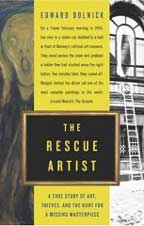Real-life tale of the theft, dramatic recovery of 'The Scream'
 Thursday, October 13, 2005
Thursday, October 13, 2005

The Rescue Artist
A True Story of Art, Thieves, and the Hunt for a Missing Masterpiece By Edward Dolnick
HarperCollins. 288 pp. $25.95
Reviewed by Richard Di Dio
Philadelphia Inquirer - Thursday, Oct. 13, 2005
A screaming came across the sky ...
Wait - check that. Unlike Pynchon's V2 rocket, The Scream was wrenched rudely from the museum wall, unceremoniously lifted through a second-story window, and allowed to clatter down an aluminum ladder into the frigid stillness of a Norwegian night.
Coming on the eve of the 1994 Winter Olympics in Oslo, the theft of Edvard Munch's iconic painting from the Norwegian Gallery was audacious in its intent and simple in its execution. Playing out in grainy slapstick, a videotape showed two thieves wedging the painting into the back seat of a small car, and then speeding off. They even had time to leave a note mocking the out-to-Munch museum security and Norwegian police.
Edward Dolnick's The Rescue Artist is a fascinating real-life tale of the theft and dramatic recovery of The Scream. It is also an informative primer on the world of outrageously expensive artwork and the eccentric collectors, colorful thieves, museum apparatchiks, and dogged investigators who inhabit it.
Dolnick's story is based on the exploits of Charley Hill, a detective with Scotland Yard's Art Squad. Rescue artist Hill is an unlikely amalgam of art expert, actor, and tough-guy cop. He is a "combination of Prince Valiant and Phillip Marlowe" who can spot the tiniest flaw in a counterfeit Magritte yet speaks in pulp-fiction-ese: "Thieves who steal works of art were usually stealing hubcaps a few years earlier." (Hill's character conjured for me, a Philadelphian, an unsettling image of former police chief John Timoney attending a wine and cheese affair before heading out on a motorcycle patrol to round up the usual suspects.)
With the Art Squad called in to assist in the case, Hill leads the recovery efforts for The Scream by taking on the dangerous undercover role of an art buyer willing to negotiate with the thieves. Dolnick's description of the planning and execution of Hill's dangerous plan is reminiscent of a le Carré novel, marrying minute detail and harrowing suspense. Hill is understandably meticulous in his preparation, immersing himself in the art and troubled life of Edvard Munch.
It is not enough for him to be an unscrupulous art connoisseur - he must be totally convincing in his passion for the patron saint of Nordic angst. He also must have the technical expertise to determine instantly whether the work is real or counterfeit when he later encounters the thieves and their prize.
Hill's self-told tales of derring-do are almost too movie-like to be totally true. As a welcome balance, Dolnick frequently breaks from the unfolding Oslo drama to provide an informative analysis of art theft that is equal parts history, economics, and psychology.
Stolen art is sometimes returned for ransom, although almost never at the value assigned by art experts. Fencing The Scream, valued at $72 million, would have been incredibly difficult because of its one-of-a-kind nature, as well as the global awareness of the theft. (There is also little validity to the Hollywood notion that eccentric billionaires are willing to buy stolen objects to keep in their private collections, unseen by anyone else.) Instead, art pieces are often used as black market barter for other illicit items - drugs, for example. Interestingly, the motivation for art theft is not necessarily greed - sometimes the art is stolen just for the thrill of the theft, or to "make a statement" to the authorities or other criminals. And sometimes, the thief simply has to have a Degas on the wall of his underworld lair.
Dolnick is the former chief science writer for the Boston Globe. In The Rescue Artist, he paints a rich background of the high-stakes world of art theft in the guise of a true thriller.
Richard Di Dio teaches physics and mathematics at La Salle University.
 R.A. DiDio
R.A. DiDio
There are 2 existing versions of The Scream. The one described in this book is the one at The National Museum of Norway in Oslo. The other version is at The Munch Museum, also in Oslo. Remarkably, this second version and "The Madonna" - another Munch were also stolen - in broad daylight - on Aug. 22, 2004. The paintings were recovered in August 2006 . At first it was believed that the paintings had not suffered permanent damage. It is now being reported that there most likely is permanent damage due to moisture and abrasion.
 R.A. DiDio |
R.A. DiDio |  4 Comments |
4 Comments | 


Reader Comments (4)
The blog content is just what I necessary, I'm keen on the blog, I'm an Nike Shox Shoes enthusiast, I'm keen on Adidas Running Shoes considerably. I can make it easier to boost your own blog and expect your blog continually up to date. Obviously, from here I still bring in http://www.sneakers4sales.com for you!
The blog content is just what I necessary.
Thanks, I'm going to have nightmares tonight. zwysfj zwysfj - <a href="http://www.birkin-hermes-bags.com">Hermes Handbags</a>.
Thanks, I'm going to have nightmares tonight. oqwifo oqwifo - <a href="http://www.monclerjackets.fr">Moncler jackets france</a>.